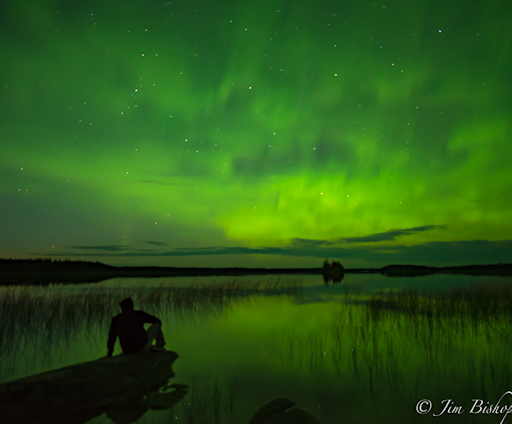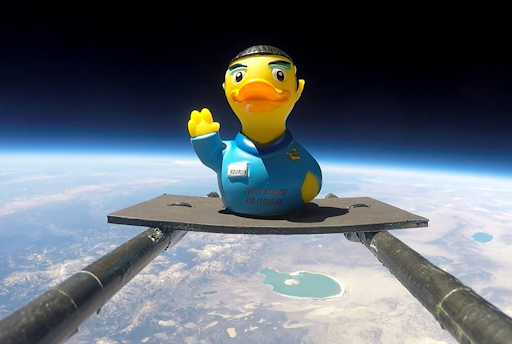It's waiting for you: The most successful Aurora Photo Tour on Earth! 100% success rate 4 years in a row and winner of the TripAdvisor Certificate of Excellence Award. Join LapplandMedia's aurora tours in Abisko, Swedish Lapland! | | | THE WHOLE LANDSCAPE TURNED GREEN: A high speed solar wind stream hit Earth's magnetic field on July 28th, and is still blowing around our planet now. The effect in Manitoba, Canada, was to turn the whole landscape green: 
"Auroras were covering most of the sky, and we had a calm wind," says photographer Jim Bishop. "I was able to set up my tripod and dash into the shot for a self-portrait." Earth's magnetic field should remain active and glowing on July 29th. NOAA forecasters estimate a 35% chance of G1-class geomagnetic storms around both poles as the solar wind continues to blow. Aurora alerts: text or voice Realtime Aurora Photo Gallery SUNRISE IN ANTARCTICA: After two months of almost total winter darkness, the sun is rising again on the outskirts of Antarctica. B Sudarsan Patro sends this picture from the Bharati Indian Base Station in the Larsemann Hills overlooking Prydz Bay (69o S): 
"Today we have observed a colorful sunrise and sunset," says Patro. "After a long wait of 65 days, the polar sun appeared and it was absolutely stunning. We all are happy to see the sun with new rays of hope." Of course, the return of the Antarctic sun reduces the hours for watching Southern Lights. But daytime has its rewards, too. Stay tuned for more images from the frozen continent. Realtime Space Weather Photo Gallery THE PERSEID METEOR SHOWER IS BEGINNING: Earth is entering a broad stream of debris from comet Swift-Tuttle, source of the annual Perseid meteor shower. NASA cameras detected the first Perseid fireballs of 2016 on July 26th. This one, photographed over Mt. Lemmon Observatory in Arizona, was easily visible through the glare of a waning quarter moon: 
In the 3 nights since that first sighting, NASA's network of all-sky meteor cameras has detected more than a dozen Perseid fireballs over the USA. These numbers will grow sharply in the weeks ahead. Forecasters expect the shower to peak on August 11-13 with as many as 200 Perseids per hour. On those nights, Earth will pass through a dense thicket of debris from the parent comet, causing a display widely visible across the northern hemisphere. The 2016 Perseids are going to be great. Stay tuned for observing tips and more information. WHERE NO DUCK HAS GONE BEFORE: Yes, that really is a Vulcan rubber duck! The students of Earth to Sky Calculus flew the pointy-eared water bird to the stratosphere on July 19, 2016, as part of their ongoing program to monitor cosmic rays in the stratosphere. Here he is at the apex of the flight, 109,580 ft: 
"Mr Squawk" hitchhiked on a helium balloon payload that carried an array of X-ray/gamma-ray sensors. By launching these sensors 3 or 4 times a month, the students have shown that cosmic rays are intensifying--a trend that affects mountain climbers, air travelers, high-altitude drones and astronauts on the International Space Station. This research is crowd funded. Would you like to support it? Buy a duck! Edge of Space Vulcan Ducks are now available in the Earth to Sky Store.
Realtime Noctilucent Cloud Photo Gallery
Realtime Sprite Photo Gallery Every night, a network of NASA all-sky cameras scans the skies above the United States for meteoritic fireballs. Automated software maintained by NASA's Meteoroid Environment Office calculates their orbits, velocity, penetration depth in Earth's atmosphere and many other characteristics. Daily results are presented here on Spaceweather.com. On Jul. 29, 2016, the network reported 40 fireballs.
(25 sporadics, 6 Southern delta Aquariids, 5 Perseids, 3 alpha Capricornids, 1 August Lyncid)  In this diagram of the inner solar system, all of the fireball orbits intersect at a single point--Earth. The orbits are color-coded by velocity, from slow (red) to fast (blue). [Larger image] [movies] Potentially Hazardous Asteroids ( PHAs) are space rocks larger than approximately 100m that can come closer to Earth than 0.05 AU. None of the known PHAs is on a collision course with our planet, although astronomers are finding new ones all the time. On July 29, 2016 there were potentially hazardous asteroids. Notes: LD means "Lunar Distance." 1 LD = 384,401 km, the distance between Earth and the Moon. 1 LD also equals 0.00256 AU. MAG is the visual magnitude of the asteroid on the date of closest approach. | | Cosmic Rays in the Atmosphere | | Situation Report -- Oct. 30, 2015 | Stratospheric Radiation (+37o N) | | Cosmic ray levels are elevated (+6.1% above the Space Age median). The trend is flat. Cosmic ray levels have increased +0% in the past month. | | Sept. 06: 4.14 uSv/hr (414 uRad/hr) | | Sept. 12: 4.09 uSv/hr (409 uRad/hr) | | Sept. 23: 4.12 uSv/hr (412 uRad/hr) | | Sept. 25: 4.16 uSv/hr (416 uRad/hr) | | Sept. 27: 4.13 uSv/hr (413 uRad/hr) | | Oct. 11: 4.02 uSv/hr (402 uRad/hr) | | Oct. 22: 4.11 uSv/hr (411 uRad/hr) | These measurements are based on regular space weather balloon flights: learn more. Approximately once a week, Spaceweather.com and the students of Earth to Sky Calculus fly "space weather balloons" to the stratosphere over California. These balloons are equipped with radiation sensors that detect cosmic rays, a surprisingly "down to Earth" form of space weather. Cosmic rays can seed clouds, trigger lightning, and penetrate commercial airplanes. Our measurements show that someone flying back and forth across the continental USA, just once, can absorb as much ionizing radiation as 2 to 5 dental X-rays. For example, here is the data from a flight on Oct. 22, 2015: 
Radiation levels peak at the entrance to the stratosphere in a broad region called the "Pfotzer Maximum." This peak is named after physicist George Pfotzer who discovered it using balloons and Geiger tubes in the 1930s. Radiation levels there are more than 80x sea level. Note that the bottom of the Pfotzer Maximim is near 55,000 ft. This means that some high-flying aircraft are not far from the zone of maximum radiation. Indeed, according to the Oct 22th measurements, a plane flying at 45,000 feet is exposed to 2.79 uSv/hr. At that rate, a passenger would absorb about one dental X-ray's worth of radiation in about 5 hours. The radiation sensors onboard our helium balloons detect X-rays and gamma-rays in the energy range 10 keV to 20 MeV. These energies span the range of medical X-ray machines and airport security scanners. | | The official U.S. government space weather bureau | | | The first place to look for information about sundogs, pillars, rainbows and related phenomena. | | | Researchers call it a "Hubble for the sun." SDO is the most advanced solar observatory ever. | | | 3D views of the sun from NASA's Solar and Terrestrial Relations Observatory | | | Realtime and archival images of the Sun from SOHO. | | | from the NOAA Space Environment Center | | | the underlying science of space weather |  | Tobi -- Proud Supporter of Space Education! |  | Claim your tax refund with this UK tax rebate company and get back your overpaid tax. |  | Enjoy this fabulous range of leather sofas from a leader in the UK sofa manufacturer industry.. | | 
